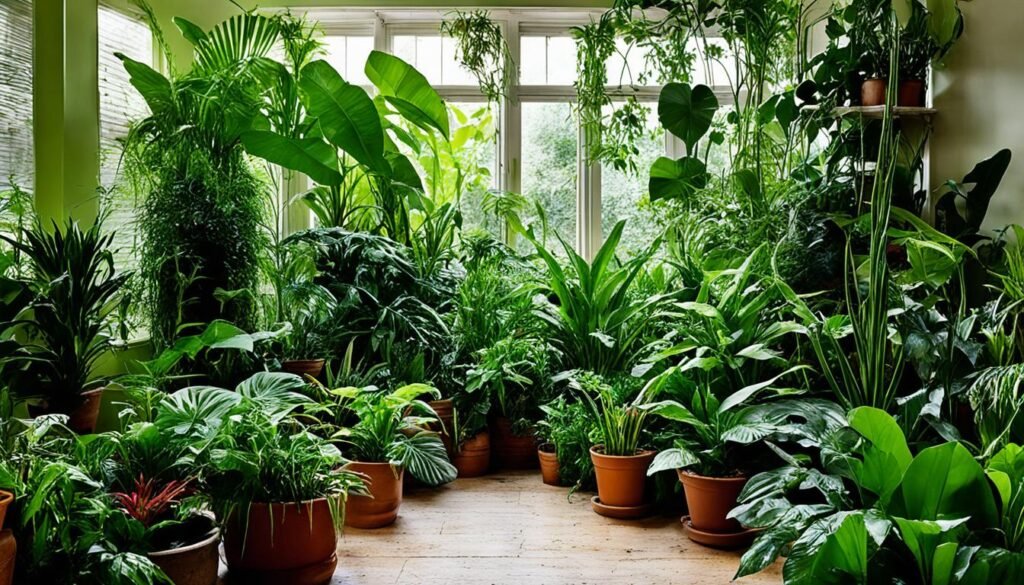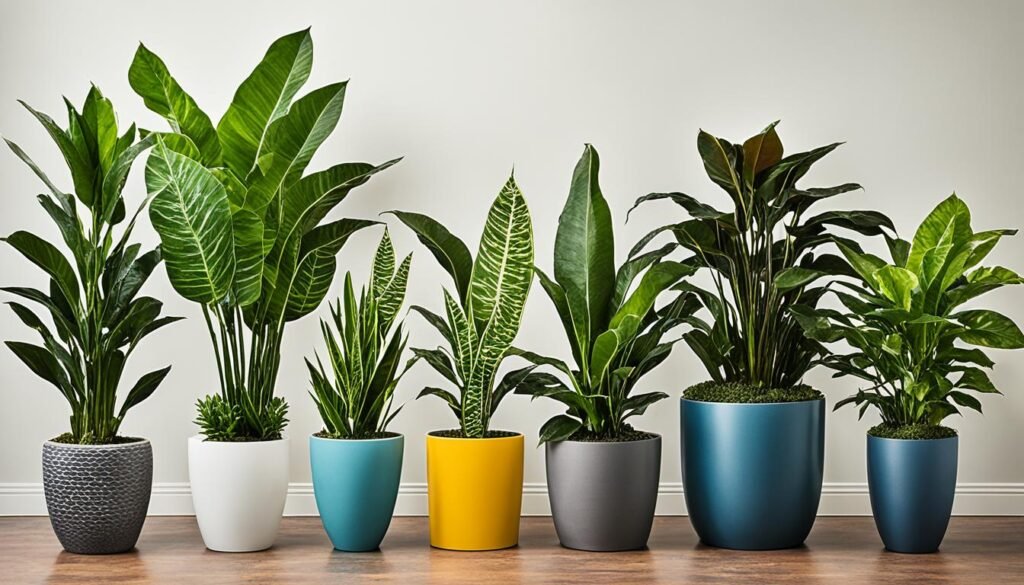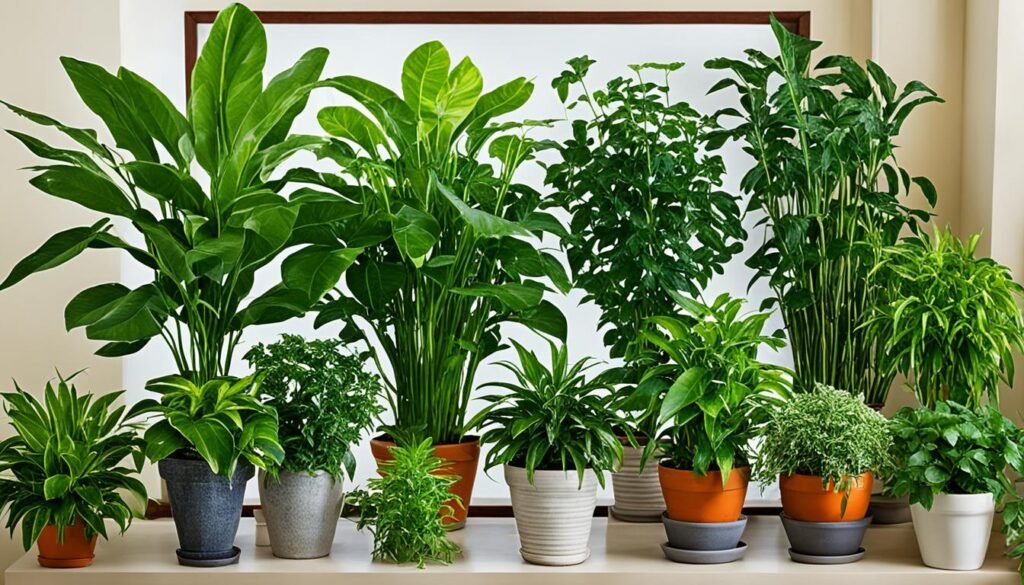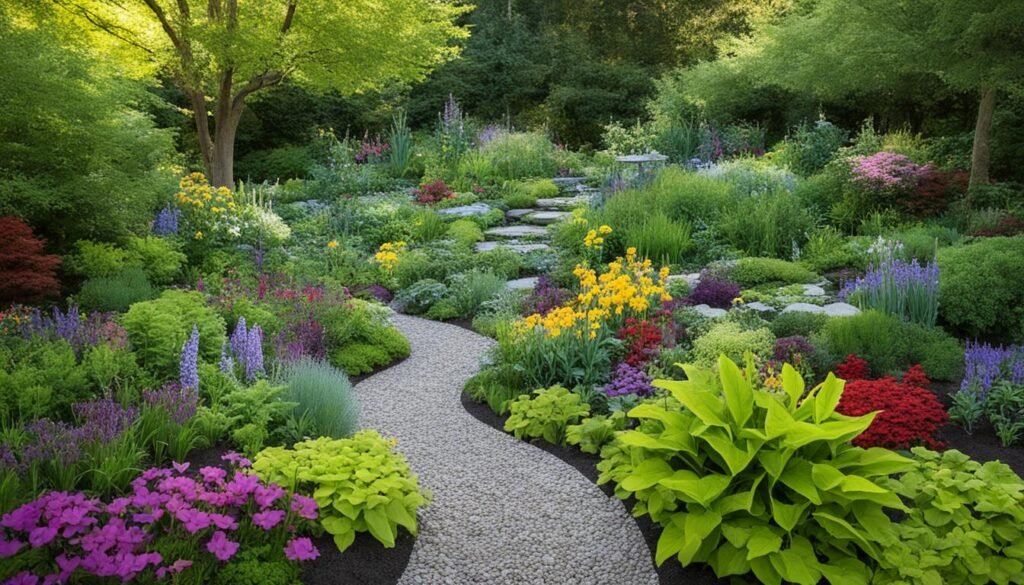Welcome to a stunning visual guide of 7 large indoor plants that can transform your home aesthetic. If you’re looking for greenery inspiration to elevate your living space, you’ve come to the right place. These magnificent plants not only add a touch of natural beauty but also provide numerous benefits to plant lovers seeking to enrich their home environment with lush greenery.
From the iconic Fiddle Leaf Fig to the exotic Bird of Paradise, each of these plants has been chosen for its unique appeal and ability to thrive indoors. Scroll down and start planning your next indoor jungle with these captivating large indoor plants!
Why Choose Large Indoor Plants for Your Home
Selecting large indoor plants for your home brings numerous benefits for both aesthetics and health. These plants boost the visual appeal of your space, acting as natural decor. They also serve as striking statement pieces, drawing attention in any room.
Large indoor plants are key to improving air quality. They absorb toxins, creating a healthier living environment. This, in turn, reduces stress and enhances overall well-being, making them essential for modern homes.
These plants also introduce a calming green element to your space, uplifting the mood. The dual benefits of cleaner air and mental well-being highlight the value of large plants in your home. Their role as both natural decor and artistic statement pieces adds to their appeal.
Top 7 Large Indoor Plant Selections
Adding large indoor plants to your home can turn it into a lush indoor jungle. These selections not only provide impactful foliage but also offer low maintenance and air-purifying qualities. They are perfect for both novice and experienced plant enthusiasts.
Fiddle Leaf Fig
The Fiddle Leaf Fig is celebrated for its broad, glossy leaves. It excels in bright, indirect light and requires moderate watering. This plant adds a dramatic touch to any room, while its air-purifying qualities enhance indoor air quality.
Rubber Plant
The Rubber Plant is distinguished by its large, dark green leaves. It’s a top choice for creating an indoor jungle with its striking appearance. Preferring bright, indirect light, it’s low maintenance, needing water only when the soil feels dry.
Monstera Deliciosa
Monstera Deliciosa, also known as the Swiss Cheese Plant, features unique, perforated leaves for an exotic look. Its low maintenance nature makes it a favorite. Moreover, it’s excellent at improving indoor air quality, making it a smart choice for any home.
Bird of Paradise
The Bird of Paradise brings a tropical feel with its vibrant, sprawling foliage. It thrives in bright light and requires regular watering to stay healthy. This plant’s impactful foliage and air-purifying qualities make it a standout addition to any indoor jungle.
Snake Plant
The Snake Plant is renowned for its sword-like leaves. It’s incredibly low maintenance, tolerating low light and infrequent watering. Perfect for busy individuals, it effectively removes toxins from the air, promoting a healthier living space.

ZZ Plant
The ZZ Plant, with its waxy, oval leaves, is another low maintenance option. It can tolerate low light and infrequent watering, thriving in almost any environment. Its ability to purify indoor air adds an extra layer of appeal.
Dracaena Marginata
Dracaena Marginata, or the Dragon Tree, is notable for its slender, arching leaves. It requires minimal care, needing indirect light and occasional watering. This plant not only enhances the indoor jungle feel but also offers air-purifying benefits.
| Plant | Light Requirements | Watering Needs |
|---|---|---|
| Fiddle Leaf Fig | Bright, indirect | Moderate |
| Rubber Plant | Bright, indirect | Dry soil |
| Monstera Deliciosa | Bright, indirect | Low |
| Bird of Paradise | Bright | Regular |
| Snake Plant | Low light | Infrequent |
| ZZ Plant | Low light | Infrequent |
| Dracaena Marginata | Indirect light | Occasional |
Choosing the Right Indoor Plant Pots
Selecting the right indoor plant pots is crucial for enhancing your indoor garden. The ideal pots meet your plants’ needs and complement your home’s design, reflecting your style.
Consideration for Size and Material
The size and material of the pot are key to your plant’s health. Stylish ceramic planters combine functionality with beauty. Choose a pot that supports root growth and fits your décor.
- Size: The pot should match the plant’s size now and in the future. A pot too small can stunt growth, while one too large can cause waterlogging.
- Material: Ceramic planters are favored for their durability and style. They also protect roots from temperature changes.
Styling with Decorative Plant Containers
Decorative plant containers can change your indoor space’s look and feel. Unique indoor plant pots add individuality and charm. Explore various styles to match your taste.

- Color and Pattern: Pick colors and patterns that complement or contrast with your décor. Bold colors and intricate patterns can stand out.
- Shape and Texture: Choose pots with unique shapes and textures for visual interest. Smooth finishes or rough exteriors can highlight specific areas.
Modern vs. Contemporary Plant Pots
Your choice between modern and contemporary plant pots depends on your style. Both styles offer unique ideas, adding to your home’s ambiance.
- Modern Plant Pots: They feature clean lines, minimalistic designs, and neutral colors. Ideal for a sleek, tidy look.
- Contemporary Plant Pots: These incorporate the latest trends and materials, bringing a fresh vibe to your space. They often combine metal, glass, and innovative materials.
| Feature | Modern Plant Pots | Contemporary Plant Pots |
|---|---|---|
| Design | Minimalistic, Clean lines | Trend-driven, Eclectic |
| Color Scheme | Neutral, Monochromatic | Vibrant, Varied |
| Material | Ceramic, Metal | Mixed materials |
Your choice of plant pots should meet both your plants’ needs and your aesthetic. By blending practicality with style, you create a beautiful and harmonious indoor garden.
Indoor Plant Care Tips
To keep indoor plants vibrant and healthy, focus on watering, light, and soil. These tips will guide you in creating a plant care routine that ensures your plants flourish all year.
Watering and Moisture Control
Watering is key for indoor plants. Too much water can cause root rot, while too little can make leaves wilt. Set a watering schedule that suits each plant’s needs. Use pots with good drainage and check the soil before watering.
Light and Placement
Position your plants where they get the right amount of light. Some plants need bright, indirect light, while others do well in low light. Placing them near suitable light sources helps them grow well.

Soil and Fertilization
Choosing the right soil is vital for healthy plants. Go for high-quality potting mix that ensures good air flow and drainage. Also, fertilize regularly to provide the necessary nutrients for a strong plant care routine.
| Aspect | Tips for Thriving Greenery |
|---|---|
| Watering | Monitor soil moisture, water consistently, avoid overwatering. |
| Light | Place plants according to their light needs; balance light exposure. |
| Soil | Utilize quality potting mix for optimal growth and aeration. |
| Fertilization | Follow a balanced schedule to ensure adequate nutrient supply. |
Conclusion
Indoor gardening is a delightful way to improve your living space and enrich your lifestyle. By adding plants like the Fiddle Leaf Fig, Rubber Plant, and Monstera Deliciosa, your home becomes a peaceful, green sanctuary. This transformation turns your space into a true indoor oasis.
However, indoor gardening is more than just picking the right plants. The choice of plant pots, whether modern or contemporary, is vital for matching your home’s decor. It’s also crucial to understand the basics of plant care. This includes watering, controlling moisture, placing lights, and fertilizing the soil for success.
Embracing indoor gardening enhances your lifestyle and creates a lush, green environment that boosts your well-being. With the knowledge from this guide, you’re ready to create your own indoor oasis. Enjoy the many benefits of growing large indoor plants.
FAQ
What are the benefits of having large indoor plants in my home?
Large indoor plants not only enhance your home’s aesthetic but also boost air quality and mental well-being. They act as focal points, adding a natural touch to your decor.
Which large indoor plants are best for beginners?
For beginners, consider the Rubber Plant, Snake Plant, and ZZ Plant. These plants are easy to care for and help purify the air.
How should I choose the right indoor plant pots for my large plants?
When selecting pots, think about the size and material that fit your plant’s needs and your decor. Ceramic and decorative containers can elevate your indoor garden’s style.
What is the difference between modern and contemporary plant pots?
Modern pots tend to be sleek and minimalist, while contemporary ones blend current trends with artistic flair. Both styles can beautifully showcase your plants.
How often should I water my large indoor plants?
Watering frequency varies by plant type. As a rule, water when the top inch of soil is dry. Ensure you avoid overwatering by maintaining proper moisture levels.
What type of light do large indoor plants need?
Most large indoor plants thrive in bright, indirect light. Yet, some like the Snake Plant and ZZ Plant can survive with less light. Position them near windows with filtered light for best growth.
What kind of soil and fertilization do large indoor plants require?
Use soil that drains well to prevent root rot. Feed your plants during their active growth periods, usually spring and summer. A balanced, water-soluble fertilizer suits most large indoor plants well.

